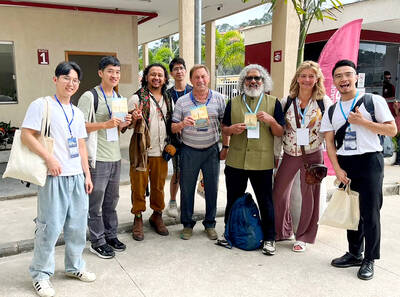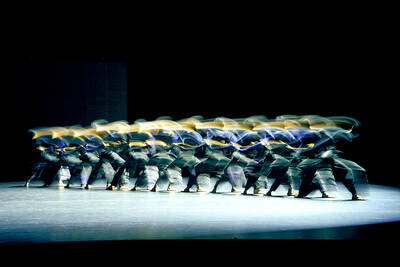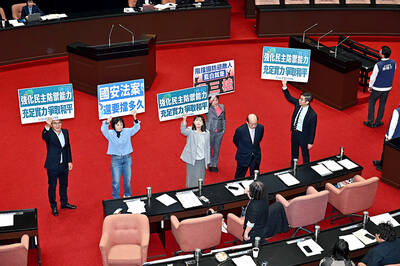The problem with academics who are also politicians is that they tend to say one thing when in office, and something quite different when they’re in academia.
This certainly applies to National Security Council (NSC) Secretary-General Su Chi (蘇起), who is both an academic and has a long history of involvement in government under former president Lee Teng-hui (李登輝) and in the Ma Ying-jeou (馬英九) administration, and served as a legislator for the Chinese Nationalist Party (KMT) for a good part of Chen Shui-bian’s (陳水扁) presidency. Su the political animal has a weakness for hyperbole, such as when, in October 2007, he claimed that Taiwan was developing nuclear weapons, which was false.
A consequence of this is that Su the academic must be approached with caution. That being said, this does not mean Taiwan’s Relations with Mainland China is a bad book. In fact, it’s a fairly good book — at least when Su manages to restrain his political Mr Hyde.
Su’s book covers the period from 1988 through 2004, which includes tentative efforts to open diplomatic talks across the Taiwan Strait all the way to the end of Chen’s first term as president.
The core argument is that from 1988 until 1995, Taiwan and China acted pragmatically and launched a series of talks — initially secret — that culminated in official dialogue between the Straits Exchange Foundation and the Association for Relations Across the Taiwan Strait (ARATS).
Su covers this period in detail, all the way down to a fascinating description of the protocol adopted to ensure “equality” between the two sides when they met, from symmetrical table arrangements to who was to speak first at press conferences.
Those talks gave rise to the so-called “1992 Consensus,” a term coined by Su that he says served as a viable alternative to thornier (and for Taiwan at times unacceptable) terminology such as “one China, respective interpretations.” While Su admits that the term was nothing more than a euphemism, he maintains that its ambiguity allowed the two sides to shelve differences and continue the talks.
Not only does this seven-year period coincide with China’s economic takeoff and opening to foreign investment, but it also marked a time when Beijing hoped that it could talk with Lee. In Su’s view, if there is mutual trust between the two sides and common ground can be found on the basis of “one China,” it is possible to build a stable, win-win relationship.
The SEF-ARATS meetings, which remained largely symbolic and did not achieve much of substance besides agenda-setting for future talks, were derailed by two developments of Lee’s making: his visit to Cornell University in June 1995, and the development of the Two-States Theory in 1999 — namely that Taiwan and China are two countries that exit on each side of the Taiwan Strait. Beijing’s reaction to Lee’s visit to his alma mater, Su argues, was based on the perception that Washington was attempting to drive a wedge between Taipei and Beijing and prompted the latter to launch the “offense by the pen and intimidation by the sword” campaign.
The following year, China fired missiles off the waters of Taiwan during the presidential election.
If the Cornell visit derailed cross-strait dialogue, the Two-States Theory “bombshell” sank it, Su argues.
Allegedly commissioned by Lee, directed by the NSC and using “special secret funds,” the drafters of the Two-States Theory documents worked under such secrecy, Su argues, that it was “a true mockery of the development process of a nation that claims to be democratic.”
Su, who was Mainland Affairs Council (MAC) chairman at the time, laments that he was kept in the dark, and argues that “Mr Democracy” — a nickname given to Lee — had set up “his own mini government” for the exercise, which he says either received intellectual contributions from pro-independence elements in the DPP, or at minimum “laid the policy foundations” for the Chen administration that came into office the following year. Nevertheless, it is DPP Chairwoman Tsai Ying-wen (蔡英文), rather than Lee, who emerges as the main antagonist in Su’s description of the process.
Thus ends a period in cross-strait relations that Su perceives as offering great opportunities for rapprochement.
It also opens a section of the book where Su becomes far more overtly politicized, sounding like a KMT apparatchik and using ideologically laden language. For example, while the great majority of his sources come from pan-blue (ie, pro-KMT) media, on the few occasions where he quotes from papers that are more favorable to the DPP, he invariably prefaces the passage with “pan-green” or “pro-green,” as if their credibility were more questionable as a result.
Su also joins the chorus of voices claiming that Beijing was acting rationally while the Chen administration was acting irrationally, its members following their “hearts” rather than their “heads.”
He portrays the DPP as intransigent, increasingly radical (on the independence issue) and opposed to cross-strait economic development, while conveniently ignoring the fact that by 2006, official two-way trade between Taiwan and China had almost tripled from the 1999 figure, as did approved investment in China, however difficult it is to determine the exact numbers.
Su also repeats the line that the DPP hurt Taiwan’s economy, while making no mention of China’s efforts to throttle it, or the global financial downturn that began in 2001. He is also silent on the KMT’s domination of the Legislature and the many budgets — including the MAC’s — that it froze.
This said, his analysis of the Chen Cabinet’s failure to reassess Taiwan’s position in the wake of the Sept. 11, 2001, terrorist attacks in the US is helpful and less objectionable. Chen’s national security team indeed “failed at its mission during this period” and by doing so managed to irritate Washington at a time when its focus was on Afghanistan and the Middle East.
That Taipei’s “irrational” troublemaking stemmed from a fear that Taiwan’s interests risked being ignored by the shift in US focus and Washington’s growing reliance on Beijing, however, is unexplored by Su, who prefers to believe that Chen et al could only think of themselves. His assessment of DPP diplomats, whom he does not hold in high esteem, fails to take into consideration the fact that the DPP had never been in power, did not have the web of contacts the KMT had enjoyed abroad for half a century, and that for decades the KMT had repressed and depleted the future leaders of the opposition in Taiwan.
In all, Su’s is a very informative book, which besides presenting large amounts of hard-to-find data opens a window on the KMT’s perception of the political environment. That achievement, however, is undermined by bias language — the Two States “theory” vs One China “policy” — and an often self-serving selection of sources, especially in his coverage of the March 19, 2004, election eve shooting incident.
His conclusion, meanwhile, exposes Su the politician, where he makes wild and often misinformed assertions about democracy and identity that entirely depart from the otherwise cooler voice he adopts earlier in his book. It is also no small irony that the secrecy and “mockery of democracy” he deplores in the Two States Theory drafting process has become characteristic of Ma’s administration.
In his acknowledgements, Su makes a touching ode to his fortunes as a child growing up in Taiwan, and how the nation’s economic development and democracy gave him opportunities that would have been unthinkable in China. Su the government official seems to have forgotten that.

Most heroes are remembered for the battles they fought. Taiwan’s Black Bat Squadron is remembered for flying into Chinese airspace 838 times between 1953 and 1967, and for the 148 men whose sacrifice bought the intelligence that kept Taiwan secure. Two-thirds of the squadron died carrying out missions most people wouldn’t learn about for another 40 years. The squadron lost 15 aircraft and 148 crew members over those 14 years, making it the deadliest unit in Taiwan’s military history by casualty rate. They flew at night, often at low altitudes, straight into some of the most heavily defended airspace in Asia.

Many people in Taiwan first learned about universal basic income (UBI) — the idea that the government should provide regular, no-strings-attached payments to each citizen — in 2019. While seeking the Democratic nomination for the 2020 US presidential election, Andrew Yang, a politician of Taiwanese descent, said that, if elected, he’d institute a UBI of US$1,000 per month to “get the economic boot off of people’s throats, allowing them to lift their heads up, breathe, and get excited for the future.” His campaign petered out, but the concept of UBI hasn’t gone away. Throughout the industrialized world, there are fears that

Like much in the world today, theater has experienced major disruptions over the six years since COVID-19. The pandemic, the war in Ukraine and social media have created a new normal of geopolitical and information uncertainty, and the performing arts are not immune to these effects. “Ten years ago people wanted to come to the theater to engage with important issues, but now the Internet allows them to engage with those issues powerfully and immediately,” said Faith Tan, programming director of the Esplanade in Singapore, speaking last week in Japan. “One reaction to unpredictability has been a renewed emphasis on

Taiwan’s democracy is at risk. Be very alarmed. This is not a drill. The current constitutional crisis progressed slowly, then suddenly. Political tensions, partisan hostility and emotions are all running high right when cool heads and calm negotiation are most needed. Oxford defines brinkmanship as: “The art or practice of pursuing a dangerous policy to the limits of safety before stopping, especially in politics.” It says the term comes from a quote from a 1956 Cold War interview with then-American Secretary of State John Foster Dulles, when he said: ‘The ability to get to the verge without getting into the war is